Defining and implementing skill-based pay strategies in the knowledge economy
In this article, we explain skill-based pay strategies in the knowledge economy. It covers the benefits, challenges, implementation steps, and how skills management software can support these strategies.

Driven by the globalization of markets and the rapid pace of technological innovation, the knowledge economy has transformed the nature of work. Some of this is beneficial. The knowledge economy has, for example, created opportunities for entrepreneurship and innovation via the emergence of new technologies and business models.
However, it has also contributed to growing income inequality and a widening skills gap between high-skilled and low-skilled workers – highlighting the need for organizational strategies that promote education and training, such as skill-based pay.
First, let’s take a closer look at the knowledge economy.
What is the knowledge economy?Copied
The “knowledge economy” is a term used to describe economic activity driven by the production, distribution, and use of knowledge, skills, and information to produce goods and services. Typically, knowledge economies incorporate activities that rely more on knowledge and information – such as research and development, education, consulting, and information technology – into traditional economies, such as manufacturing.
In knowledge economies, skilled employees are highly valued and in demand – and their skills and expertise are crucial for organizations to remain competitive and innovative. These employees are also expected to be career-long learners, however, with constant upskilling and reskilling necessary to keep up with the latest developments in their fields.
This poses a challenge to companies leveraging traditional pay structures, which focus more on job title and seniority – and do not always reward skills – putting them at risk to employee dissatisfaction and turnover.
To combat this – and in hopes of attracting and retaining high-skilled workers who can drive innovation and create value – global organizations are increasingly turning to skill-based pay strategies.
What is skill-based pay? Copied
Skill-based pay is a compensation strategy that rewards employees based on knowledge level, skills, and abilities, rather than job title or seniority. Such strategies fit snugly into knowledge economies, acting as a direct link between pay, skills, and performance. They also serve as a signal to prospective employees that companies recognize the changing nature of work, as well as employees’ value to the organization.
The benefits of skill-based payCopied
Skill-based pay strategies are designed to elicit several key benefits for both organizations and employees.
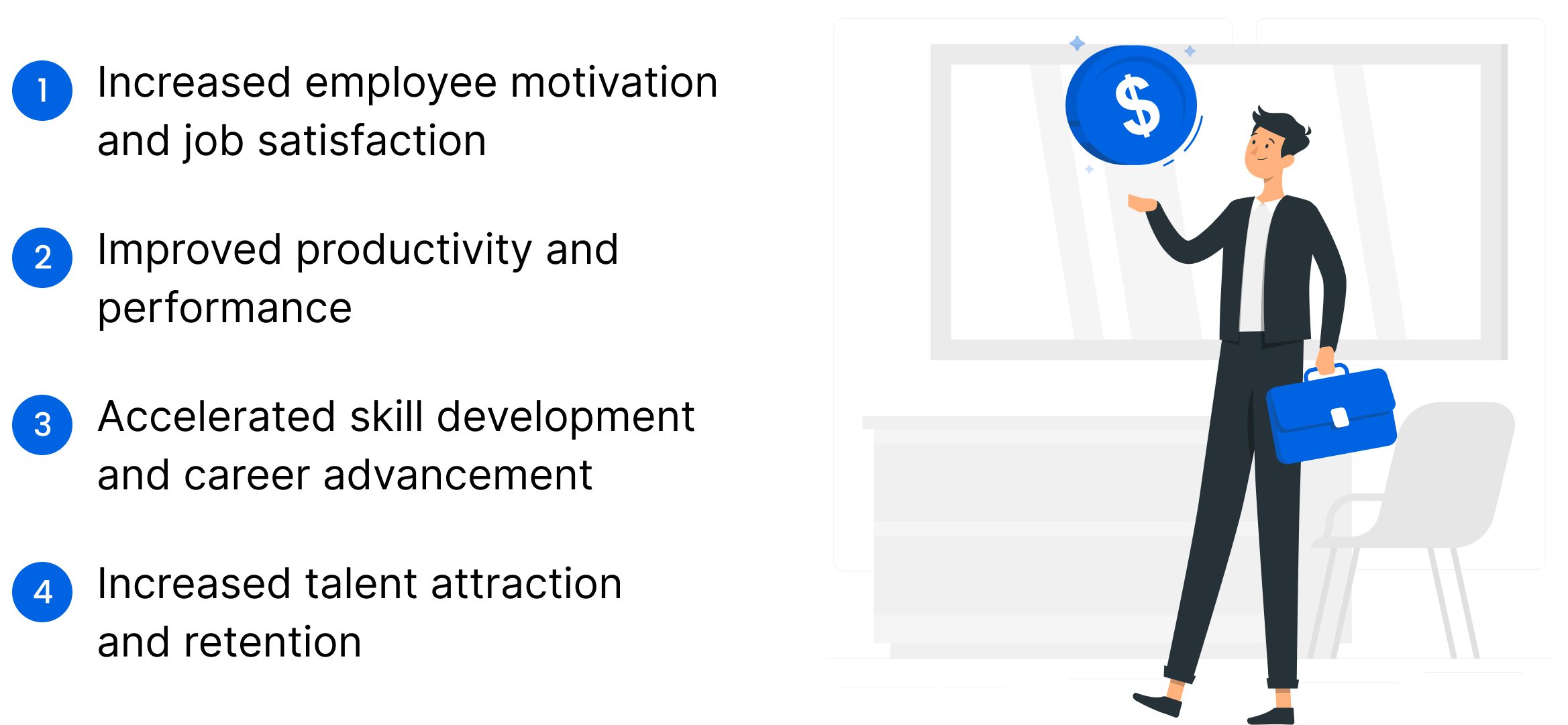
Increased employee motivation and job satisfaction
When recognized and rewarded for their skills and expertise, employees are more likely to feel a sense of accomplishment and recognition for their work, leading to greater motivation and job satisfaction.
Improved productivity and performance
Skill-based pay can increase employee productivity and performance by providing clear incentives for employees to develop their skills and expertise.
Accelerated skill development and career advancement
By offering incentives for employees to develop new skills and knowledge, organizations can help foster a culture of continuous learning and professional growth. This can lead to a more engaged and motivated workforce, while helping ensure that organizations have the talent (and skills) they need to stay competitive.
Increased talent attraction and retention
By offering higher compensation for specialized skills and expertise, organizations can create a compelling value proposition for high-performing employees and job candidates.
The challenges of skill-based pay Copied
While skill-based pay strategies offer numerous benefits, they are not without challenges. To avoid them, you must first understand them.
Complex and time-consuming
Skill-based pay strategies require organizations to accurately assess the skills and knowledge of each employee and develop a system for measuring and compensating skill levels. This can be a significant challenge, particularly for large organizations with complex job structures – although it can be mitigated or avoided completely by leveraging suitable skills management strategies.
Employee competition and conflict
When compensation is tied to skills and expertise, employees may feel that they are competing with each other for pay increases. This can lead to resentment and conflict in the workplace, particularly if employees feel that skill assessments are unfair or inaccurate. Avoiding this requires careful planning and clear roadmaps that employees can easily understand and follow.
Mistrust and bias
There is a risk that employees may overstate their skills and expertise in order to receive higher compensation, or that managers may be biased in their assessment of skills. This can lead to a lack of trust in the skill-based pay system and undermine employee motivation and job satisfaction. Here, companies can work to develop clear, objective methods of assessing skills that leave no room for confusion or conflict.
Not one-size-fits-all
Some jobs may require a high level of technical expertise or specialized skills, while others may be more generalist in nature. In such cases, a skill-based pay system may not accurately reflect the value of the work being performed, and may create disparities in compensation between different job types.
To address this challenge, consider implementing a pay system that takes into account the complexity and demands of each job type. One option is a job-based pay system, which determines compensation based on the level of responsibility, complexity, and skills required for each job. This can help ensure that employees are fairly compensated for the specific requirements of their job.

Another option is a hybrid pay system that combines elements of both job-based and skill-based pay systems. Hybrid pay systems are especially useful in cases where some roles require both specialized skills and a high level of responsibility, while others are more general in nature.
Skill-based pay in actionCopied
In a 2021 survey conducted by Willis Towers Watson, 43% of respondents said that their companies plan to increase their use of skill-based pay in the coming years. With that in mind – and before making a decision to switch to a skill-based pay strategy – it may be beneficial to examine several high-profile organizations that have successfully implemented them.
Low-cost, US-based Southwest Airlines for example, has a pay system that is based on the skills and experience of its employees. This has allowed the company to attract and retain top talent, while also improving customer satisfaction and profitability.
Whole Foods Market, an American luxury supermarket chain, also rewards employees for developing their skills and knowledge, which has led to high levels of employee engagement and customer satisfaction.
Meanwhile, Lincoln Electric, a globally focused organization that produces welding equipment, has used skill-based pay for more than a century. The company believes that its pay system has contributed to its success, as it encourages employees to continuously improve their skills and performance.
Companies such as Google, Microsoft, and Apple are also prime examples of companies leveraging skill-based pay strategies. There, employees are targeted and recruited not based on degree, but on ability and skill – and summarily paid to reflect that.
Implementing a skill-based pay strategyCopied
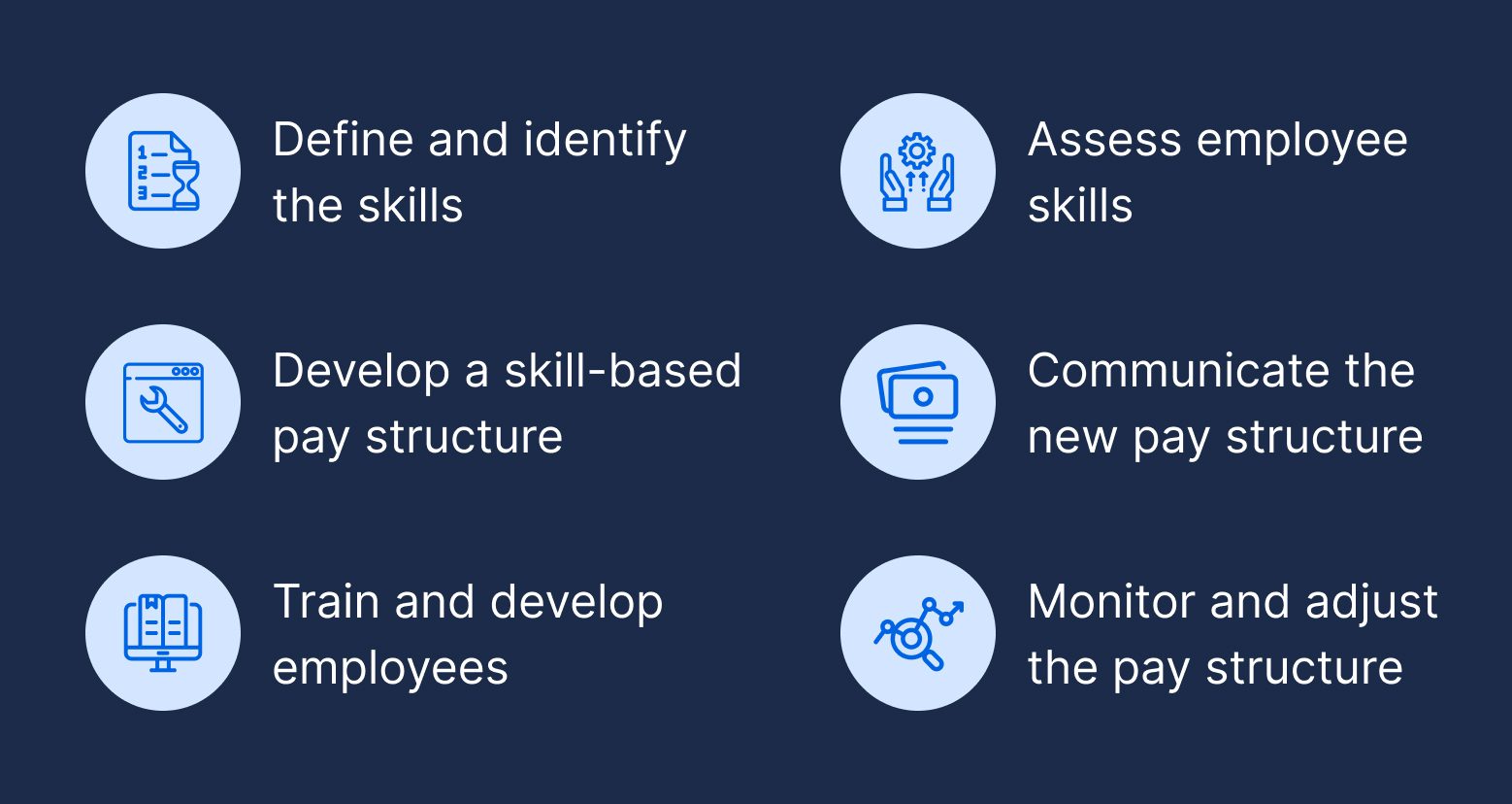
Implementing a skill-based pay system requires determining skill levels and pay ranges, communicating the pay system to employees, evaluating and rewarding performance, and managing potential drawbacks and challenges. It’s a complex process – as described above – but it is nonetheless essential for ensuring that the system is fair and effective.
- Define and identify the skills. This can be done through job analysis and evaluation, in which a job’s tasks, responsibilities, and requirements are studied in detail to identify the essential skills.
- Assess employee skills. Employees’ skills must also be assessed to determine their level of competency. This can be accomplished through various methods such as skill tests, performance evaluations, and employee self-assessments.
- Develop a skill-based pay structure. A skill-based pay structure should clearly define the pay scale for each skill level, as well as how employees can progress through it.
- Communicate the new pay structure. Employees must understand how the new skill-based pay structure works, their opportunities for advancement, and how they can improve their skills to increase their pay.
- Train and develop employees. Training and development opportunities should be provided to help employees improve their skills and move up the skill-based pay ladder. This can include on-the-job training, mentoring, and formal training programs.
- Monitor and adjust the pay structure. Regular monitoring and adjustment of the skill-based pay structure should be conducted to ensure it remains relevant and effective. This may involve updating the skills required for each job role or adjusting the pay levels based on market trends or business needs.
The role of skills management software in skill-based payCopied
Skills management software can play an integral role in both designing and implementing skill-based pay strategies. Because of their complex nature – and especially in large or highly technical organizations – these strategies are often difficult to manage and maintain. Skills-management software alleviates many of these frustrations.
In this section, we’ll take a look at how AG5’s skills management solutions approaches and navigates challenges posed by skill-based pay.
Identifying skills gaps
Skills management software can help identify the skills required for each role in an organization or team, which is an essential step in developing a skill-based pay strategy.
AG5 allows for easy competency mapping and provides a clear overview of all skills present in an organization – and those that are needed. This enables you to identify skills gaps before they appear, or close those that already exist.
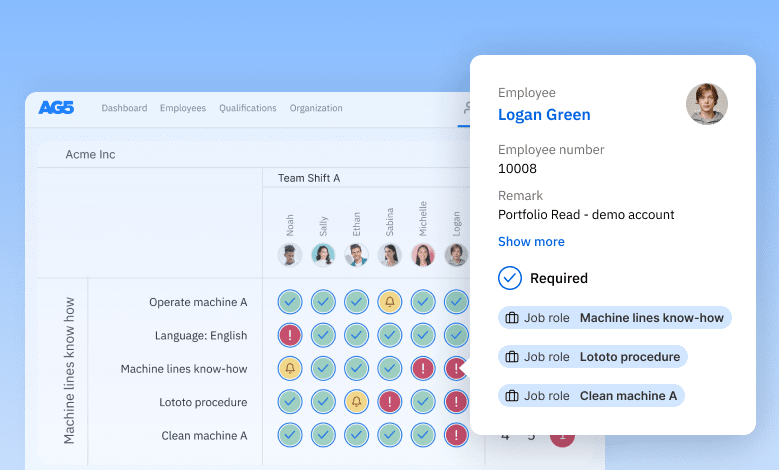
Tracking employee progress
Skills management software can track the progress of employees as they develop their skills and move up the skill-based pay ladder. This can help managers identify high-performing employees and reward them accordingly.
Here, AG5’s intuitive skills matrices and employee insights page come into play, providing real-time information regarding employee skills, certifications, qualifications, and other relevant information.
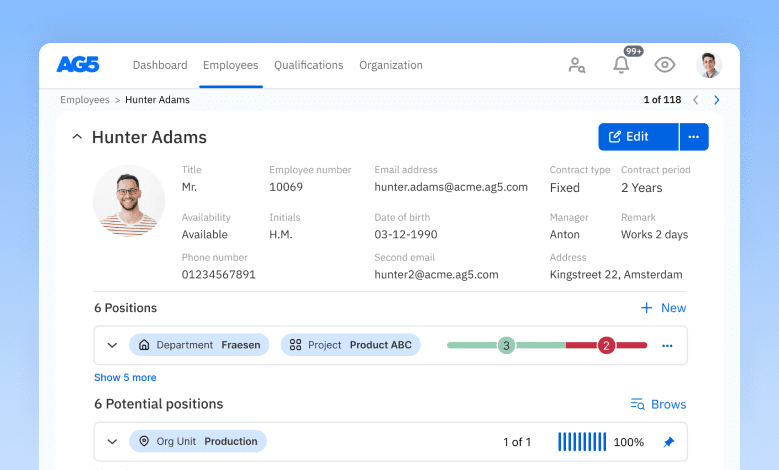
Improve training plans
Skills management software can help managers improve training plans by targeting skills that are required for certain teams or projects. This can help employees upskill and progress through skill-based pay levels.
AG5 provides you with this insight via a clear, intuitive dashboard. This will allow you to tailor your existing training plans to your needs, ensuring that your employees – and your organization – make the most of your skill-based pay strategy.
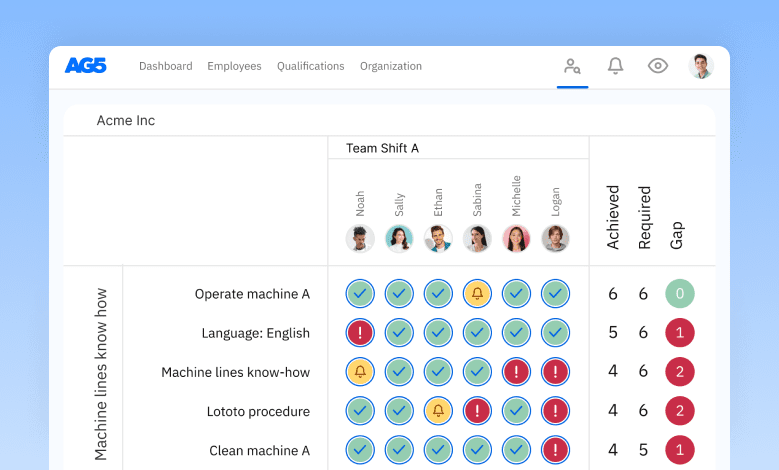
Monitoring the effectiveness of the skill-based pay strategy
You can determine a skill-based pay strategy’s efficacy by leveraging the skill-related data and analytics that skills management software collects and interprets. This can help managers identify areas for improvement and adjust the strategy accordingly.
AG5’s platform uses skills-related data to generate employee-specific and organization-wide skills reports, helping organizations with skill-based pay strategies ensure they are running as efficiently and effectively as possible.
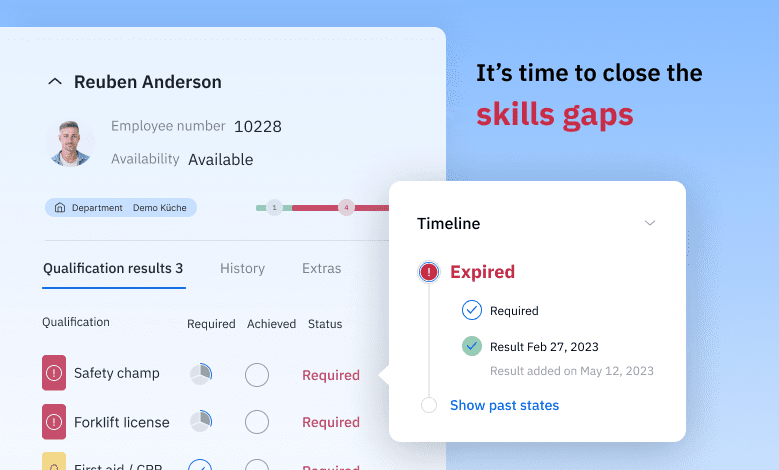
Ready to get started?Copied
Ready to take the first step on your skills management journey? Get in touch today for a free, 15-minute remote demo – and see how AG5 can transform the way you operate.

